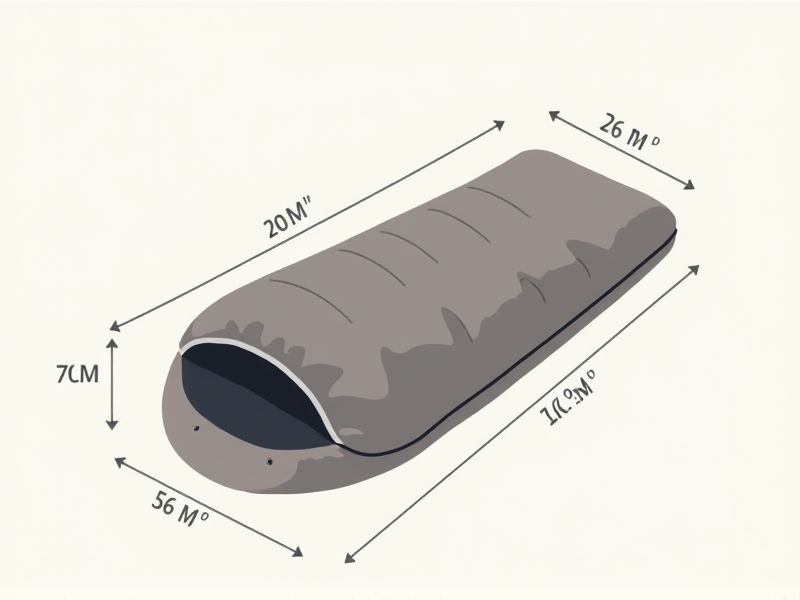
Sleeping bags commonly come in standard dimensions designed to fit most adults comfortably. A typical adult rectangular sleeping bag measures around 75 to 80 inches (190 to 203 cm) in length and 30 to 36 inches (76 to 91 cm) in width. Mummy-style sleeping bags, which are more tapered for warmth, usually range from 78 to 86 inches (198 to 218 cm) long and 28 to 33 inches (71 to 84 cm) wide at the shoulders, narrowing toward the feet. Always check the product's specific measurements to ensure the best fit for your height and sleeping preferences.
Length Variability
When selecting a sleeping bag, consider the length variability to ensure optimal comfort and warmth. Most sleeping bags range from 5 feet 6 inches to 7 feet in length, accommodating different body sizes and sleeping styles. A proper fit can enhance insulation efficiency, as a well-sized bag minimizes air gaps that lead to heat loss. If you're taller than average, look for long models that offer additional room, as many brands also provide options specifically designed for individuals up to 6 feet 6 inches tall.
Width Choices
When selecting a sleeping bag, width options typically range from 26 to 40 inches, accommodating various body types and preferences. A narrower sleeping bag may weigh less, enhancing portability for backpackers, while a wider design provides extra space for comfort, particularly for side sleepers. Insulation type and material also play a crucial role, with options such as down or synthetic affecting both warmth and compressibility. Consider your intended use and climate, as these factors will influence the ideal width and overall fit for your sleeping bag.
Regular Size
A standard regular-size sleeping bag typically measures around 75 inches long and 30 inches wide, accommodating individuals up to 6 feet tall comfortably. Insulation materials vary, with synthetic options providing moisture resistance and down offerings providing superior warmth-to-weight ratios. Temperature ratings range widely; you might find bags rated between 20degF to 50degF, helping you choose the right one for your climate and adventure. When selecting a regular-size sleeping bag, consider features like zip length, packed dimensions, and weight for enhanced portability during your trips.
Long Size
The standard length for a sleeping bag designed for tall individuals typically measures around 86 inches (218 cm), providing ample space for users up to 6 feet 6 inches (198 cm) tall. These long sleeping bags often feature additional insulation material to maintain warmth while accommodating the extra length, ensuring comfort during colder temperatures, often rated for below freezing conditions (around 20degF or -6degC). Most models are designed with features such as a draft tube and adjustable hoods, enhancing thermal efficiency. When selecting your sleeping bag, consider weight and packability as long options can add extra bulk, usually ranging from 2 to 4 pounds (0.9 to 1.8 kg).
Extra-Long Size
An extra-long sleeping bag typically measures 90 inches in length, making it suitable for individuals up to 6 feet 6 inches tall. Designed with comfort in mind, these bags often feature insulation ratings ranging from 20degF to 40degF, catering to various outdoor temperatures. You can find extra-long sleeping bags constructed from lightweight, durable materials such as ripstop nylon or polyester, which provide excellent weather resistance and packability. Look for features like draft collars and hood cinches, which enhance warmth retention, especially during chilly nights in the wilderness.
Shoulder Girth
Shoulder girth is a critical measurement in determining the comfort and fit of a sleeping bag, influencing thermal efficiency and ease of movement. Most sleeping bags accommodate shoulder girth ranging from 50 to 70 inches, ensuring a snug yet flexible environment for various body types. Selecting a sleeping bag that aligns with your shoulder girth enhances insulation and reduces cold spots, significantly improving your outdoor experience. When choosing a sleeping bag, consider fitting your shoulder girth into the manufacturer's size chart for optimal performance and comfort.
Hip Girth
When selecting a sleeping bag, consider the hip girth measurement, typically ranging from 50 to 60 inches for standard sizes. A sleeping bag with an adequate hip girth ensures comfort and range of motion, especially for side sleepers. For optimal thermal efficiency, a snug fit around the hips reduces the volume of air that needs to be heated. Choosing a bag with a hip girth that accommodates your body shape enhances your overall sleeping experience in varying outdoor conditions.
Foot Girth
Foot girth in sleeping bags significantly impacts comfort and insulation, typically measured in inches. Standard foot girth can range from 36 to 42 inches, accommodating various user preferences and foot sizes. A properly fitted foot area ensures minimal heat loss and enhances overall warmth retention, crucial for outdoor activities in cold climates. For optimal use, choose a sleeping bag that aligns with your personal measurements, ensuring sufficient space without sacrificing warmth.
Weight Considerations
When selecting a sleeping bag, weight is a crucial factor, especially for backpackers and campers aiming to minimize their load. High-quality materials, such as down insulation or synthetic fills like polyester, significantly affect the overall weight, with down bags averaging between 1 to 3 pounds. For optimal warmth-to-weight ratios, consider bags that have a temperature rating aligned with your expected conditions, generally ranging from 20degF to 50degF for three-season use. Your choice in size, also known as the bag's length and width, can influence weight; a regular bag often weighs less than a long bag due to less material usage.
Packed Size
The packed size of a sleeping bag is a crucial factor for outdoor enthusiasts, particularly those who prioritize portability and ease of transport. Typically, a high-quality sleeping bag should have a packed size of less than 15 inches in length and 7 inches in diameter, which allows it to fit comfortably in a backpack or carry-on. When choosing a sleeping bag, consider options made from lightweight materials that compress efficiently without sacrificing insulation. Your choice of sleeping bag can significantly impact your experience, especially during extended trips where space and weight are critical.
